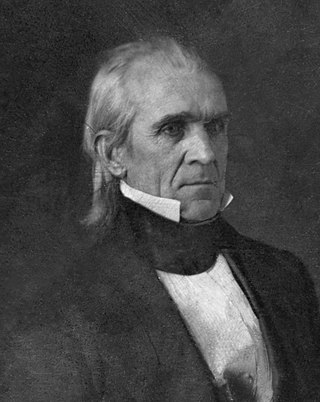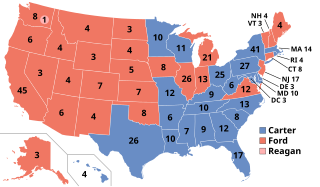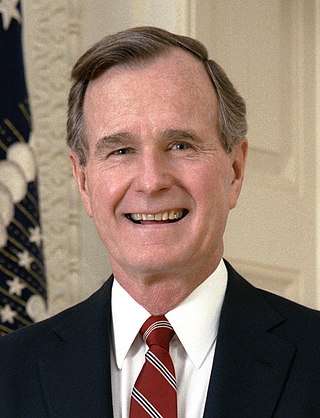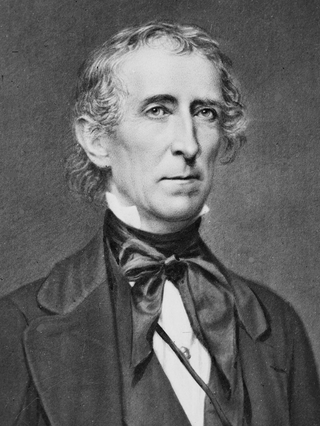
The Twelfth Amendment to the United States Constitution provides the procedure for electing the president and vice president. It replaced the procedure in Article II, Section 1, Clause 3, under which the Electoral College originally functioned. The amendment was proposed by Congress on December 9, 1803, and was ratified by the requisite three-fourths of state legislatures on June 15, 1804. The new rules took effect for the 1804 presidential election and have governed all subsequent presidential elections.

The 1996 United States presidential election was the 53rd quadrennial presidential election, held on Tuesday, November 5, 1996. Incumbent Democratic President Bill Clinton defeated former Senate Majority Leader Bob Dole, the Republican nominee, and Ross Perot, the Reform Party nominee and 1992 independent presidential candidate. This was the first election since 1944 in which the incumbent Democratic president was reelected.

The 1840 United States presidential election was the 14th quadrennial presidential election, held from Friday, October 30 to Wednesday, December 2, 1840. Economic recovery from the Panic of 1837 was incomplete, and Whig nominee William Henry Harrison defeated incumbent President Martin Van Buren of the Democratic Party. The election marked the first of two Whig victories in presidential elections, but was the only one where they won a majority of the popular vote. This was the third rematch in American history, which would not occur again until 1892.

The 1844 United States presidential election was the 15th quadrennial presidential election, held from Friday, November 1 to Wednesday, December 4, 1844. Democrat James K. Polk defeated Whig Henry Clay in a close contest turning on the controversial issues of slavery and the annexation of the Republic of Texas. This is the only election where both major party nominees served as Speaker of the House at one point, and the first where neither candidate held elected office at the time.

The 1848 United States presidential election was the 16th quadrennial presidential election, held on Tuesday, November 7, 1848. In the aftermath of the Mexican–American War, General Zachary Taylor of the Whig Party defeated Senator Lewis Cass of the Democratic Party.

The 1928 United States presidential election was the 36th quadrennial presidential election, held on Tuesday, November 6, 1928. Republican former Secretary of Commerce Herbert Hoover defeated the Democratic nominee, Governor Al Smith of New York. After President Calvin Coolidge declined to seek reelection, Hoover emerged as his party's frontrunner. As Hoover's party opponents failed to unite around a candidate, Hoover received a large majority of the vote at the 1928 Republican National Convention. The strong state of the economy discouraged some Democrats from running, and Smith was nominated on the first ballot of the 1928 Democratic National Convention. Hoover and Smith had been widely known as potential presidential candidates long before the 1928 campaign, and both were generally regarded as outstanding leaders. Both were newcomers to the presidential race and presented in their person and record an appeal of unknown potency to the electorate. Both faced serious discontent within their respective parties' membership, and both lacked the wholehearted support of their parties' organization.

The 1976 United States presidential election was the 48th quadrennial presidential election, held on Tuesday, November 2, 1976. Democrat Jimmy Carter, former Governor of Georgia, defeated incumbent Republican president Gerald Ford in a narrow victory. This was the first presidential election since 1932 in which the incumbent was defeated, as well as the only Democratic victory of the six presidential elections between 1968 and 1988.
This section of the timeline of United States history concerns events from 1820 to 1859.

The 1844 Whig National Convention was a presidential nominating convention held on May 1, 1844 at Universalist Church in Baltimore, Maryland. It nominated the Whig Party's candidates for president and vice president in the 1844 election. The convention selected former Senator Henry Clay of Kentucky for president and former Senator Theodore Frelinghuysen of New Jersey for vice president.

Presidential primaries and caucuses of the Republican Party took place within all 50 U.S. states and the District of Columbia between February 18 to June 9, 1992. These elections were designed to select the 2,277 delegates to send to the national convention in Houston, Texas from August 17 to August 20, 1992, who selected the Republican Party's nominee for president in the 1992 United States presidential election, incumbent president George H. W. Bush. The delegates also approved the party platform and vice-presidential nominee. Bush went on to lose the general election to the Democratic nominee, Governor Bill Clinton.

John Tyler was the tenth president of the United States, serving from 1841 to 1845, after briefly holding office as the tenth vice president in 1841. He was elected vice president on the 1840 Whig ticket with President William Henry Harrison, succeeding to the presidency following Harrison's death 31 days after assuming office. Tyler was a stalwart supporter and advocate of states' rights, including regarding slavery, and he adopted nationalistic policies as president only when they did not infringe on the states' powers. His unexpected rise to the presidency posed a threat to the presidential ambitions of Henry Clay and other Whig politicians and left Tyler estranged from both of the nation's major political parties at the time.

The 1984 United States presidential election in Washington took place on November 6, 1984. All 50 states and the District of Columbia, were part of the 1984 United States presidential election. Voters chose ten electors to the Electoral College, which selected the president and vice president of the United States.

The 1984 United States presidential election in Texas took place on November 6, 1984. All fifty states and the District of Columbia, were part of the 1984 United States presidential election. Texas voters chose 29 electors to the Electoral College, which selected the president and vice president of the United States.

The 1984 United States presidential election in Virginia took place on November 6, 1984. All 50 states and the District of Columbia, were part of the 1984 United States presidential election. Virginia voters chose 12 electors to the Electoral College, which selected the president and vice president of the United States.

The 1844 United States elections elected the members of the 29th United States Congress, and took place during the Second Party System in the midst of the debate over whether to annex Texas. Texas and Iowa joined the union during the 29th Congress. Democrats retained control of the House and took back control of the presidency and the Senate, re-establishing the dominant position the party had lost in the 1840 election.

The 1838 Republic of Texas presidential election was the second presidential election. It was held on September 3, 1838. By a provision of the constitution, the term of office of the first president was limited to two years, without his being eligible for re-election; succeeding presidents were to hold their office for three years.
The 1844 Republic of Texas presidential election was the fourth and last presidential election. It was held on September 2, 1844. The contest was held between Anson Jones and Edward Burleson, the vice president of the Republic of Texas. Jones defeated Burleson by a margin of 1,376 votes to become the fourth and final President of Texas.
The election of the president and vice president of the Republic of China is a universal direct election through secret vote by the citizens of the Republic of China (ROC) in the Taiwan Area. ROC presidents are elected by simple majority, meaning the candidate with the most votes wins without a runoff requirement. The most recent election took place on January 11, 2020.

The 1968 United States presidential election in Texas was held on November 5, 1968. All 50 states and the District of Columbia, were part of the 1968 United States presidential election. The state chose 25 electors to represent them in the Electoral College, who voted for president and vice president.

The 1888 United States presidential election in Texas took place on November 6, 1888, as part of the 1888 United States presidential election. State voters chose 13 representatives, or electors, to the Electoral College, who voted for president and vice president.



















